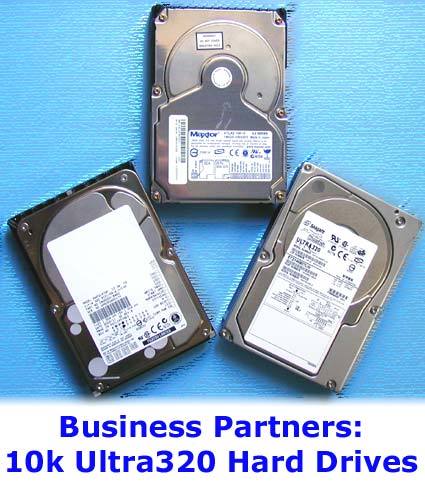Reliable Business Partners: Three Ultra320 Hard Drives at 10,000 RPM
Business Partner Round-Up: Ultra320 Hard Drives From Fujitsu, Maxtor And Seagate
Only a few years ago, picking out the best hard drive interface was still a simple affair: ATA was for home or office computers, SCSI for all professional applications. Now, choosing a hard drive for business applications is no longer as easy. ATA hard drives will soon be as fast as, (on average) twice as large as, and much cheaper than, SCSI drives. The temptation is enormous - is it even worth fighting it any longer?
Most definitely! The moment you start demanding more of your hard drives than just brute data-transfer rates and capacity, you will have to base your decisions on more than just the price. For example, SCSI is a must for applications that must not fail no matter what (infrastructural systems or those keeping your business going).
There are big quality differences between ATA and SCSI drives. Most low-cost hard drives (i.e., almost all ATA models) have not been designed for continuous operation. Constant use puts more mechanical and thermal stress on a drive than is put on drives in desktop systems, which barely run at all in comparison. The drive also has to be robust enough to survive non-stop use under the most adverse of conditions, like when the air-conditioning in the server room breaks down.
Despite everything, ATA hard drives are being used more and more for small server systems. Webhosters have fallen in love with the ability to build these components into attractive systems that they can rent out on the cheap. In those cases, it's the customer who has to bear the risk of a hard drive defect causing failures.
In practice, though, ATA hard drives have caused relatively few problems during continuous operation. The biggest headaches are bound to come from hard drive manufacturers that cropped warranty periods last fall. They will only vouch for most ATA models for a laughable twelve months (except for the two-year warranty requirement in the EU).
This is a sore spot: server systems generally have to tough it out for several years (if only for tax reasons). That's the big unknown: will ATA hard drives be able to handle several more years of service even after two years of non-stop operation - or will you see more errors crop up as wear and tear take their toll?
There's really only one thing we can recommend: use only top-notch hard drives for your crucial applications - and that covers more than just business-critical ones. There's even a sort of reward in it for you - a respectable five-year warranty period and better performance than with ATA models, as all modern SCSI drives run at 10,000 rpm or faster.
Get Tom's Hardware's best news and in-depth reviews, straight to your inbox.
All told, there are four models in the standard 3.5" format to choose from: the MAP series from Fujitsu, Hitachi's UltraStar DK32EJ, the Maxtor Atlas 10K IV and Seagate's Cheetah 10K.6. Unfortunately, we didn't receive the UltraStar from Hitachi in enough time to include it in this article. We will, however, follow up with its scores as soon as possible.
Current page: Business Partner Round-Up: Ultra320 Hard Drives From Fujitsu, Maxtor And Seagate
Next Page The Candidates: Similar Features
Patrick Schmid was the editor-in-chief for Tom's Hardware from 2005 to 2006. He wrote numerous articles on a wide range of hardware topics, including storage, CPUs, and system builds.
